It looks like you're using an Ad Blocker.
Please white-list or disable AboveTopSecret.com in your ad-blocking tool.
Thank you.
Some features of ATS will be disabled while you continue to use an ad-blocker.
3
share:
Perhaps one of the most influential but least known African civilization is the Ejagham, growing up in Jamaica I some times came across designs done
with white chalk on the ground this was mostly in the country side when I inquired I was told not to be nosy or those designs were the work of the
Obeah man (healer priest) in any case mind your own business,years later I came across the book Flash Of The Spirit (highly recommended) and low and
behold child hood memories flashed back the drawings looked the same and the artist had their origins in a civilization called the Ejagham and their
designs called Nisibidi.
Origin
The Ekoi believe that the heirs of the first settlers of their present settlement own the land; while newcomers are not allowed to buy land, they are able to purchase rights of settlement. Ekoi men have traditionally hunted, while women have engaged in agriculture, raising yams, plantains, and corn (maize). Women also fish, and both men and women participate in weaving.
Rulers
Ekoi towns are ruled by councils of elders, but townspeople are free to attend meetings. Native courts that were instituted under British administration provide an appeals system outside of the decision making by the elders. Representatives from various towns sit on the courts.
en.wikipedia.org...
Wiki Sourced but backed up by the book in hand.
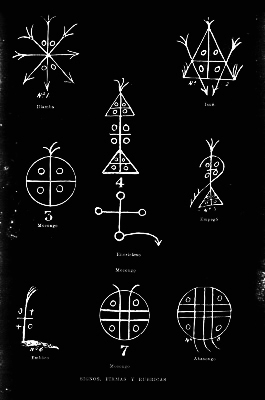
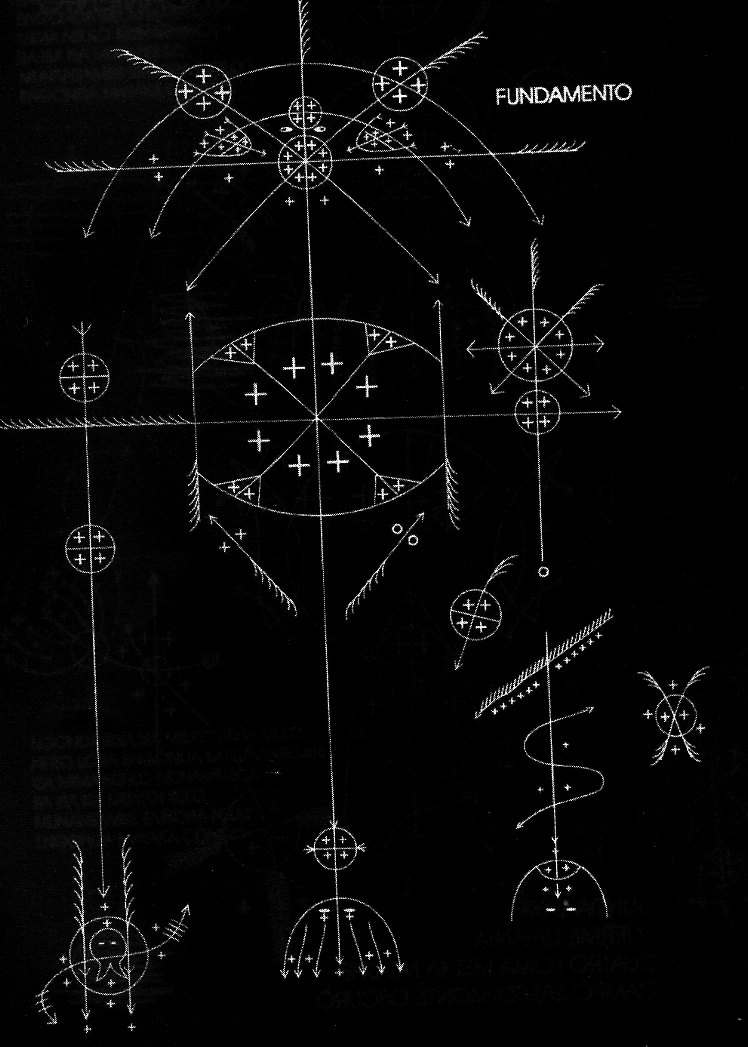
Nisibidi is a writing system of African origins,but it's not the only one there are about 16 different scripts that was in use in Africa,some ancient some as recent as the late 19th century.
1 Ethiopic Script
2 Egyptian Script
3 Sudan Script
4 Afan Oromo script
5 Bassa Script
6 Vai Script
7 Mende Script
8 Nsibidi Script
9 Edo/Benin Script
10 Tifinagh Script
11 Bamun Script
12 Kukakui Script
13 N'ko Script
14 Mandombe Script
15 Shumom Script
The most influencial African script out side of Egypt in the America's is in my view the Nisibidi,most of it is used by African based secret sociaties who know their meaning the other great users of this script is used by Grandmas of all types for the purpose of design.

Nsibidi is an ancient system of graphic communication indigenous to the Ejagham peoples of southeastern Nigeria and southwestern Cameroon in the Cross River region. It is also used by neighboring Ibibio, Efik and Igbo peoples. Aesthetically compelling and encoded, nsibidi does not correspond to any one spoken language. It is an ideographic script whose symbols refer to abstract concepts, actions or things and whose use facilitates communication among peoples speaking different languages.
Nsibidi comprises nearly a thousand symbols that can be drawn in the air (as gestures), on the ground, on skin (as tattoos), on houses and on art forms, such as masks and textiles. Though it is enjoyed as an artistic practice by the general public, deeper knowledge of the nsibidi symbols is restricted to members of men's associations, which once controlled trade and maintained social and political order.
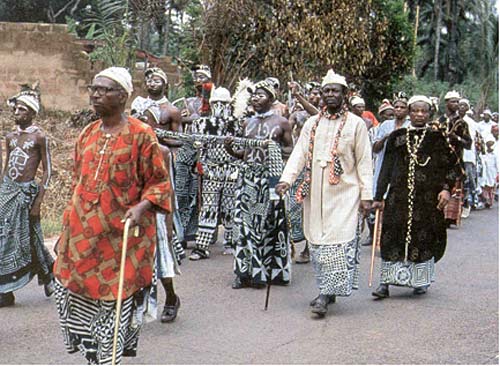
Nigerian Leopard Society members have created some of the most brilliant and elaborate displays of nsibidi. On ritual occasions, members create a dramatic presence with nsibidi-laden ukara cloth. An abundance of signs (leopards, lizards, drums, staffs, geometric and organic shapes) cover the surface of the cloths that each member ties around his waist to form a long skirt. The nsibidi is created by tightly stitching the design on a white cloth that is then dyed with indigo. After drying, the stitching and ties are removed to reveal the white nsibidi signs that appear against the deep blue background, creating a stunning cloth that is immediately recognizable as an emblem of the Leopard Society and a testament to their possession of knowledge, power, and beauty.
africa.si.edu...
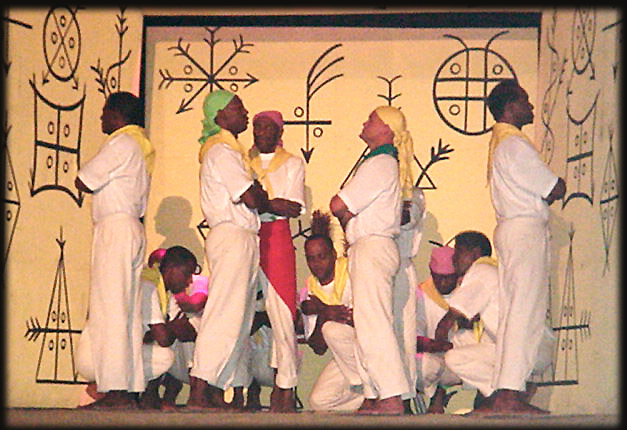
The Leopard societies in Cuba and other parts of the New world is a secret society instigating slave revolts behind the scenes, in Cuba the are called Abakua or the Leopard people.
Ejagham influence in American quilt making
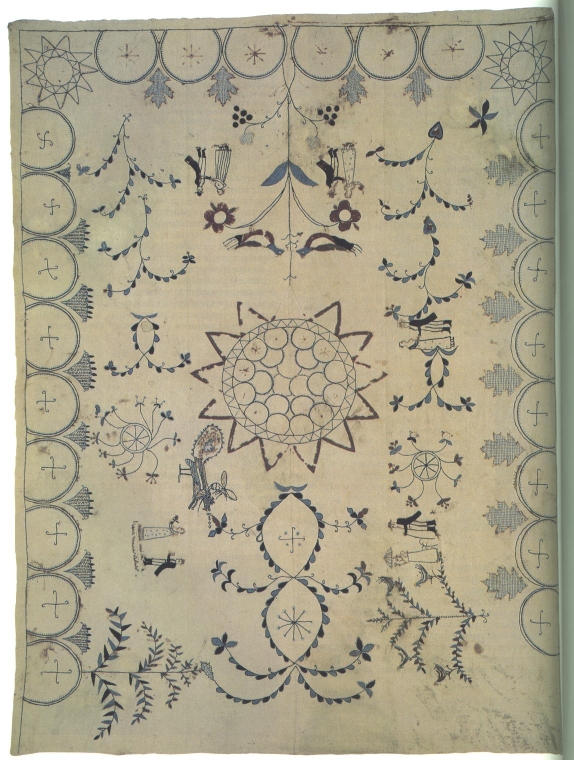
Made by a white Tennessean of German ancestry in 1792
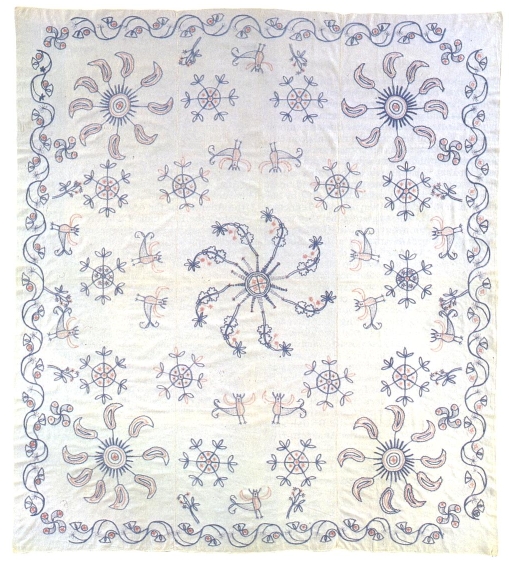
or this one, made by a white Connecticut woman in 1813?
ugrrquilt.hartcottagequilts.com...
Please click ^ for more reading

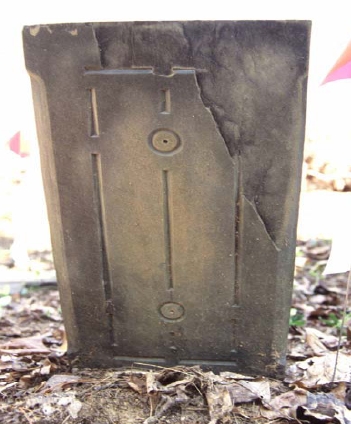
The basis of Malcolm-Woods's dissertation is her conclusion that the cemetery's headstones are engraved with "Nsibidi, an ancient Ejagham writing system from Nigeria" (dissertation p.2) demonstrating "the existence and survival of an Igbo community despite the subjugation of slavery" and "the maintenance of African rituals and beliefs in antebellum Virginia" (dissertation p.1) Approvingly citing Hidden in Plain View (so far as to use the book's title as the heading for Chapter 4 (dissertation p.104), she draws a connection between the "quilt code" symbols and the marks on the headstones (dissertation p.41).
www.ugrrquilt.hartcottagequilts.com...
Now open for contribution and comments.
Origin
The Ekoi believe that the heirs of the first settlers of their present settlement own the land; while newcomers are not allowed to buy land, they are able to purchase rights of settlement. Ekoi men have traditionally hunted, while women have engaged in agriculture, raising yams, plantains, and corn (maize). Women also fish, and both men and women participate in weaving.
Rulers
Ekoi towns are ruled by councils of elders, but townspeople are free to attend meetings. Native courts that were instituted under British administration provide an appeals system outside of the decision making by the elders. Representatives from various towns sit on the courts.
en.wikipedia.org...
Wiki Sourced but backed up by the book in hand.


Nisibidi is a writing system of African origins,but it's not the only one there are about 16 different scripts that was in use in Africa,some ancient some as recent as the late 19th century.
1 Ethiopic Script
2 Egyptian Script
3 Sudan Script
4 Afan Oromo script
5 Bassa Script
6 Vai Script
7 Mende Script
8 Nsibidi Script
9 Edo/Benin Script
10 Tifinagh Script
11 Bamun Script
12 Kukakui Script
13 N'ko Script
14 Mandombe Script
15 Shumom Script
The most influencial African script out side of Egypt in the America's is in my view the Nisibidi,most of it is used by African based secret sociaties who know their meaning the other great users of this script is used by Grandmas of all types for the purpose of design.

Nsibidi is an ancient system of graphic communication indigenous to the Ejagham peoples of southeastern Nigeria and southwestern Cameroon in the Cross River region. It is also used by neighboring Ibibio, Efik and Igbo peoples. Aesthetically compelling and encoded, nsibidi does not correspond to any one spoken language. It is an ideographic script whose symbols refer to abstract concepts, actions or things and whose use facilitates communication among peoples speaking different languages.
Nsibidi comprises nearly a thousand symbols that can be drawn in the air (as gestures), on the ground, on skin (as tattoos), on houses and on art forms, such as masks and textiles. Though it is enjoyed as an artistic practice by the general public, deeper knowledge of the nsibidi symbols is restricted to members of men's associations, which once controlled trade and maintained social and political order.

Nigerian Leopard Society members have created some of the most brilliant and elaborate displays of nsibidi. On ritual occasions, members create a dramatic presence with nsibidi-laden ukara cloth. An abundance of signs (leopards, lizards, drums, staffs, geometric and organic shapes) cover the surface of the cloths that each member ties around his waist to form a long skirt. The nsibidi is created by tightly stitching the design on a white cloth that is then dyed with indigo. After drying, the stitching and ties are removed to reveal the white nsibidi signs that appear against the deep blue background, creating a stunning cloth that is immediately recognizable as an emblem of the Leopard Society and a testament to their possession of knowledge, power, and beauty.
africa.si.edu...

The Leopard societies in Cuba and other parts of the New world is a secret society instigating slave revolts behind the scenes, in Cuba the are called Abakua or the Leopard people.
Ejagham influence in American quilt making

Made by a white Tennessean of German ancestry in 1792

or this one, made by a white Connecticut woman in 1813?
ugrrquilt.hartcottagequilts.com...
Please click ^ for more reading


The basis of Malcolm-Woods's dissertation is her conclusion that the cemetery's headstones are engraved with "Nsibidi, an ancient Ejagham writing system from Nigeria" (dissertation p.2) demonstrating "the existence and survival of an Igbo community despite the subjugation of slavery" and "the maintenance of African rituals and beliefs in antebellum Virginia" (dissertation p.1) Approvingly citing Hidden in Plain View (so far as to use the book's title as the heading for Chapter 4 (dissertation p.104), she draws a connection between the "quilt code" symbols and the marks on the headstones (dissertation p.41).
www.ugrrquilt.hartcottagequilts.com...
Now open for contribution and comments.
edit on 25-2-2013 by Spider879 because: (no reason given)
These remind of me sigil magic.
I don't really know if you know much about it (I'm certainly no expert) -- but basically people put their intent down in the form of a symbol in the hopes that the intent will come to pass.
Some people believe that corporate logos like the McDonalds "M" are sigils, altering reality in a way to make their business profitable.
It would make sense that you were told that it was the writing of a priest.
Sigils also remind me a little of runes. It seems that our ancestors world-wide knew the power of symbology.
I don't really know if you know much about it (I'm certainly no expert) -- but basically people put their intent down in the form of a symbol in the hopes that the intent will come to pass.
Some people believe that corporate logos like the McDonalds "M" are sigils, altering reality in a way to make their business profitable.
It would make sense that you were told that it was the writing of a priest.
Sigils also remind me a little of runes. It seems that our ancestors world-wide knew the power of symbology.
Originally posted by MystikMushroom
These remind of me sigil magic.
I don't really know if you know much about it (I'm certainly no expert) -- but basically people put their intent down in the form of a symbol in the hopes that the intent will come to pass.
Some people believe that corporate logos like the McDonalds "M" are sigils, altering reality in a way to make their business profitable.
It would make sense that you were told that it was the writing of a priest.
Sigils also remind me a little of runes. It seems that our ancestors world-wide knew the power of symbology.
Yes they are sometimes employed by gangs from Latin America but strangely enough not from the English speaking Caribbean where they also exist.
The first thing that came to mind when I saw this was the symbols used in Vaudon (voodoo.) I'd done some reading on this at various times, and the
idea that you were told to not inquire further as a child suggests to me that they were being done by Houngans or Mambos.
I don't, however, agree that the German quilt patterns are derived from those -- that's actually a traditional art form in Germany and derives from other sources.
The idea that there are a thousand signs is interesting (one wonders why they didn't develop writing but stuck with signage) -- I'll have to read further on this. I see some indications (the fork design) that some of the signs are more recently derived.
Thanks for the links!
I don't, however, agree that the German quilt patterns are derived from those -- that's actually a traditional art form in Germany and derives from other sources.
The idea that there are a thousand signs is interesting (one wonders why they didn't develop writing but stuck with signage) -- I'll have to read further on this. I see some indications (the fork design) that some of the signs are more recently derived.
Thanks for the links!
edit on 27-2-2013 by Byrd because: (no reason given)
Originally posted by Byrd
The first thing that came to mind when I saw this was the symbols used in Vaudon (voodoo.) I'd done some reading on this at various times, and the idea that you were told to not inquire further as a child suggests to me that they were being done by Houngans or Mambos.
I don't, however, agree that the German quilt patterns are derived from those -- that's actually a traditional art form in Germany and derives from other sources.
The idea that there are a thousand signs is interesting (one wonders why they didn't develop writing but stuck with signage) -- I'll have to read further on this. I see some indications (the fork design) that some of the signs are more recently derived.
Thanks for the links!edit on 27-2-2013 by Byrd because: (no reason given)
Yes German quilt patterns did not derive from the Nisibidi forms only that the lady mentioned above had close contacts with African Americans around her so this was a specific case.
I am still curious as to why it's so hush hushed in the English speaking caribbean but celebrated more openly in Spanish speaking countries.
Originally posted by Spider879
Yes German quilt patterns did not derive from the Nisibidi forms only that the lady mentioned above had close contacts with African Americans around her so this was a specific case.
Aha! (that's what I love about your threads... you come up with some very interesting material!)
I am still curious as to why it's so hush hushed in the English speaking caribbean but celebrated more openly in Spanish speaking countries.
Hmm. That's interesting. I wonder if it's that the symbols blend better with Catholicism (which uses symbols and emblems for the saints) than the English (Protestants) -- who would tend to want to stamp it out because it "reeks of idolatry."
In truth, I don't know. I'm just speculating. But (as an artist) I love the symbols!
reply to post by Byrd
Yes indeed Catholicism is more syncretic than protestantism the answer was right in front of me all this time.
That's interesting. I wonder if it's that the symbols blend better with Catholicism (which uses symbols and emblems for the saints) than the English (Protestants) -- who would tend to want to stamp it out because it "reeks of idolatry."
Yes indeed Catholicism is more syncretic than protestantism the answer was right in front of me all this time.
new topics
-
More Proof of Lawfare
US Political Madness: 5 hours ago -
I thought Trump was the existential threat?
World War Three: 7 hours ago -
Interesting Video-UFO?
Aliens and UFOs: 7 hours ago -
Joe Biden Dabs Away Tears at Farewell White House Dinner
Politicians & People: 8 hours ago
top topics
-
I thought Trump was the existential threat?
World War Three: 7 hours ago, 18 flags -
More Proof of Lawfare
US Political Madness: 5 hours ago, 16 flags -
Joe Biden Dabs Away Tears at Farewell White House Dinner
Politicians & People: 8 hours ago, 9 flags -
Interesting Video-UFO?
Aliens and UFOs: 7 hours ago, 6 flags
active topics
-
Encouraging News Media to be MAGA-PAF Should Be a Top Priority for Trump Admin 2025-2029.
Education and Media • 77 • : WeMustCare -
The Acronym Game .. Pt.4
General Chit Chat • 983 • : FullHeathen -
More Proof of Lawfare
US Political Madness • 9 • : xuenchen -
Joe Biden Dabs Away Tears at Farewell White House Dinner
Politicians & People • 18 • : xuenchen -
Results of the use of the Oreshnik missile system in Dnepropetrovsk
World War Three • 228 • : Flyingclaydisk -
I thought Trump was the existential threat?
World War Three • 42 • : VariedcodeSole -
Interesting Video-UFO?
Aliens and UFOs • 11 • : GENERAL EYES -
Well, here we go red lines crossed Biden gives the go ahead to use long range missiles
World War Three • 356 • : Oldcarpy2 -
Ed Dowd some good news
Medical Issues & Conspiracies • 36 • : tarantulabite1 -
International Criminal Court Issues Arrest Warrant For Netanyahu
Mainstream News • 52 • : KnowItAllKnowNothin
3
